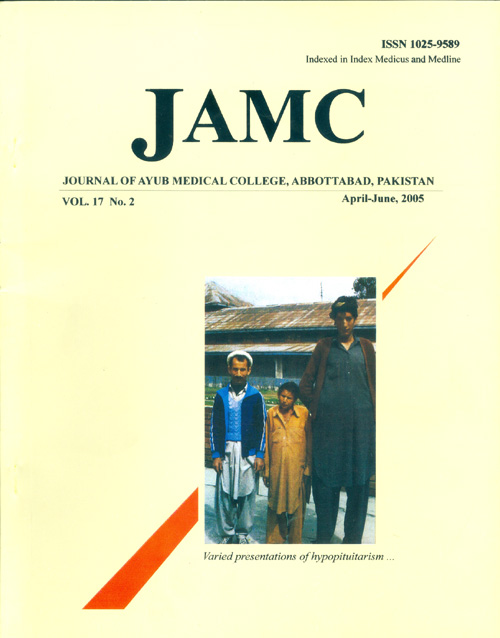A TWO YEARS AUDIT OF COMPLICATIONS OF HYSTERECTOMY AT AYUB TEACHING HOSPITAL ABBOTTABAD
Abstract
Background: Hysterectomy is one of the most common major surgical procedures performed in Gynaecology. Our objective was to determine the operative and postoperative complications of this procedure with an aim to improve management at our unit. Methods: This study was conducted in the Department of Gynaecology, Ayub Teaching Hospital, Abbottabad form January 2002 to December 2003. Indications, complications and mortality associated with hysterectomy were assessed. Results: Total number of hysterectomies performed in two years at our unit was 316. Major Indications for hysterectomies were dysfunctional uterine bleeding (38%) and fibroid uterus, (27%) followed by prolapse (22%). Complications developed in 14% out of these. The frequency of complications was related with indication for hysterectomy, age, parity and history of associated serious illness. It was found that frequency of complications in fibroid uterus was higher (1.2%) than that for Dysfunctional uterine bleeding (DUB) (1.0%). There was no operative death, while 5 (1.5%) patients died within 2 weeks of surgery. Conclusion: We have a fairly high frequency of morbidity and mortality associated with hysterectomy. In order to reduce these proper selection, pre-operative preparation and less invasive alternative treatment for the commonest indications of hysterectomy (that is fibroids and DUB) for example various methods of endometrial ablation or resections can be employed.
Keywords: Hysterectomy, Complications, morbidity, dysfunctional uterine bleeding
References
Maresh MJA, MetCalfe MA, McPherson K. The value national hysterectomy study: description of the patients and their surgery. Br J Obstet Gynaecol 2002;109:302-12
Pherson KMC, Metcalfe MA, Herbert A. Severe complications for hysterectomy; the VALUE study. Br J Obstet Gynaecol 2004;111:688-94
Harkki-Siren P, Sjoberg J, Toivonen J, Tiitinen A. Clinical outcome and tissue trauma after laparosocopic and abdominal Hystrectomy. Acta Obstet Gynecol Scand 2000:79:866-71.
Drutz HP, Main Prize TC. Unrecognized small vesico vaginal fistula as cause of persistant urinary incontinence. Am J Obstet Gynecol 1988;158:237-40.
Loft A, Anderson Tf, Bronnum Hansen H, Roepstroff C, Madsen M. Early post operative mortality following hysterectomy. A Danish population based study 1977-1981. Br J Obstet Gynaecol 1991;98:147-54.
Roos NP. Hystrectomies in one Canadian Province: a new look at risks and benefits. Am J Public Health 1983;74:39 -46
Walker W, Washington-Kirsch RL. Fatal Septicaemia after Fiberoid embolisation. Lancet 1999: 354:1730
Amstrong CA, Nichol SD, Lee DAR, Caird L. Uterine Artery embolisation for symptomatic uterine fibroids. A District General Hospital experience.
Friedman AJ, Barbieri RL, Benacerraf BR, Schieff I. Treatment of ceiomzomata with intranasal or sub cutaneous leuprolide, a gonadotropin - releasing hormone agonist. Fertil Steril 1987;48: 560-4.
Coulter A, McPhersonk, Vessey M. British women undergo too many or too few hysterectomies. Soc Sci Med 1988;27:987-94.
Wallage S, Cooper KG, Graham WJ, Parkin DE. A randomised trial comparing local versus general anaesthesia for microwave endometrial abalation. Br J Obstet Gynaecol 2003;110:799-807
Hawe JA. Cavaterm thermal balloon ablation for the treatment of memorhagia. Br J Obstet Gynaecol 1999;106:1143-8.
Sutton C. Subtotal hystrectomy revisited. End surgery 1995;3:105-8.
Boyd ME. Practical Gynaecology Surgery: Principles in practice. Baltimose: Urban and Sctwastenbury. 1990.
Rock JA, Thompson JD. Te Linde's operative Gynaecology 8th edition. Philadelphia: Lippincott - Raven, 1997.
Downloads
How to Cite
Issue
Section
License
Journal of Ayub Medical College, Abbottabad is an OPEN ACCESS JOURNAL which means that all content is FREELY available without charge to all users whether registered with the journal or not. The work published by J Ayub Med Coll Abbottabad is licensed and distributed under the creative commons License CC BY ND Attribution-NoDerivs. Material printed in this journal is OPEN to access, and are FREE for use in academic and research work with proper citation. J Ayub Med Coll Abbottabad accepts only original material for publication with the understanding that except for abstracts, no part of the data has been published or will be submitted for publication elsewhere before appearing in J Ayub Med Coll Abbottabad. The Editorial Board of J Ayub Med Coll Abbottabad makes every effort to ensure the accuracy and authenticity of material printed in J Ayub Med Coll Abbottabad. However, conclusions and statements expressed are views of the authors and do not reflect the opinion/policy of J Ayub Med Coll Abbottabad or the Editorial Board.
USERS are allowed to read, download, copy, distribute, print, search, or link to the full texts of the articles, or use them for any other lawful purpose, without asking prior permission from the publisher or the author. This is in accordance with the BOAI definition of open access.
AUTHORS retain the rights of free downloading/unlimited e-print of full text and sharing/disseminating the article without any restriction, by any means including twitter, scholarly collaboration networks such as ResearchGate, Academia.eu, and social media sites such as Twitter, LinkedIn, Google Scholar and any other professional or academic networking site.










